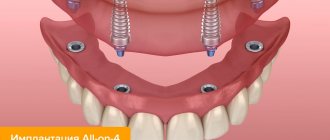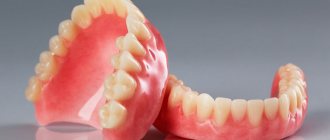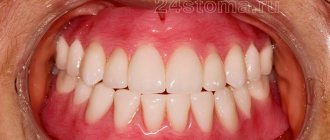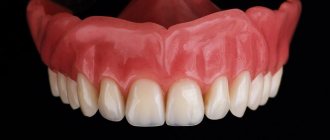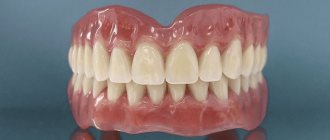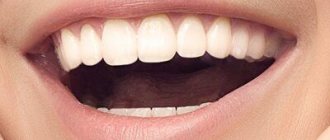Chief editor of the site:
Snitkovsky Arkady Alexandrovich
Chief physician of the professorial dentistry “22 Century”, dentist, orthopedic dentist
Author of the article:
Scientific team of dentistry “22 Century”
Dentists, candidates and doctors of medical sciences, professors
The loss of one, several or all teeth of the lower jaw leads to cosmetic and functional defects and requires urgent restoration. Modern dental clinics offer a wide range of structures that can be fixed, removable or fixed to implants, in other words, conditionally removable. Each of them has its own advantages and disadvantages, indications and contraindications. In each individual clinical case of lower jaw prosthetics , the doctor will help you decide on the most optimal option.
Price
- Primary appointment (examination, consultation) with a dentist (special offer) 100001
For free
Promotion
- Dental prosthetics Complete removable plate dentures 153003
35 000 ₽
- Manufacturing of removable dentures from Thermoplastic material 153005
49 000 ₽
- Dental prosthetics using implants Acrylic covering prosthesis with a cast frame made of CoCr alloy (excluding the cost of fixing elements: locators, spherical abutments) 154001
60 000 ₽
- Prosthetics of all jaw teeth on 4 implants
149 900 ₽
Promotion
A complete removable denture is an orthopedic design that simulates the upper or lower dentition in the absence of all teeth. Its base imitates gums and ensures fixation of the device. Artificial crowns are soldered into the base. There are removable complete dentures and conditionally removable ones. The patient can independently remove the first ones at any time. Conditionally removable structures are fixed on implants and can only be removed by a doctor. The method of prosthetics is selected taking into account the nuances of the clinical case and the patient’s preferences.
Contraindications to the installation of nylon prostheses
In the case of a complex clinical situation, when the conditions for prosthetics are not ideal - large gum atrophy, or low teeth, soft dental prostheses may not provide the ideal. In such cases, it is better to use traditional plastic prostheses:
- With short teeth, the fixation of a soft prosthesis may not be sufficient.
- A complete nylon denture is irrational in cases of severe gum atrophy. Its retention on the jaw may be far from ideal. In this case, a prosthesis made of good plastic is optimal.
- When there are one or two imperfect and mobile teeth left on the jaw, any prosthesis will not only be kept from being suctioned, but will also be fixed by them. This will definitely improve the fixation. Therefore, if there is even one tooth left on the jaw, do not rush to get rid of it - it will still be useful.
If it is subsequently removed, the traditional prosthesis can be quite easily repaired and can continue to be used.
The soft one will have to be completely redone. In general, nylon teeth are a convenient and rational option for dental restoration. The only thing is that you need to use it according to indications, and not try to use it in all situations. When a plastic prosthesis will be more rational.
Summary: indications for flexible prostheses
- Nylon dentures do not break, so they are best used in cases where breakage is very likely.
- It is rational to use a soft prosthesis in situations where it is impossible to place conventional metal clasps or they significantly worsen the aesthetics.
- If you have a strong gag reflex, an elastic denture with an open sky will not cause problems.
- In the presence of the last tooth - to restore chewing teeth without processing them.
- As a temporary prosthesis.
Service life
Like any
removable structures, a flexible prosthesis meets all the requirements for it for 3-4 years. After which it must be adjusted or redone.
Why is this necessary? Over time, inevitable atrophy of the gums and bone occurs. Both with and without a prosthesis. It occurs unevenly on the jaw. Then the prosthesis does not rest on the entire gum, but only on part of it. Causing even greater atrophy and deterioration of fixation.
These changes occur very slowly and gradually. Therefore, many patients do not notice them. And they have been using dentures for 10 and 15 years.
A regular denture can be easily relined. The nylon one will have to be remade again.
Corrections for nylon dentures are carried out in the same way as for other removable prosthetics. Usually less often.
Types of removable dentures in complete absence of teeth
Plate acrylic
Classic acrylic insert jaws are made of hard plastic. Fixation is ensured by a wide lamellar base. When biting, air comes out from under the base and a suction effect occurs. Pros: affordable price, maintainability, aesthetics. The disadvantages include deterioration of fixation as the contours of the prosthetic bed change with the need for relining, large sizes, and the need to adapt to the device. Plastic contains monomers that can cause allergies. Artificial teeth absorb dyes and odors, and after 2-3 years they lose their aesthetic properties.
Acry-Free
Monomer-free plastic Acri Free, produced in Israel, is more elastic than acrylic and does not cause allergies. Products from it are made using the injection molding method, which ensures precise fit of the base to soft tissues, as well as tight fixation. The compactness and translucency of the artificial gum make the false jaw convenient, comfortable, and aesthetically pleasing. The resistance of the structure to chewing loads prevents damage to soft tissues and also somewhat slows down atrophy. Orthopedic devices from Akri-Free are recognized as the best alternative to plastic false jaws, but they cost more.
Nylon
The main characteristic of the material of nylon prostheses is elasticity. The base is thinner, softer, and more compact than plastic, which makes false teeth comfortable for the patient. The translucency of the base ensures aesthetics. However, softness is also a disadvantage of nylon. The base quickly loses its shape, which negatively affects fixation. The device cannot be repositioned. During chewing of food, the load is not distributed, but is locally transferred to soft tissues, which causes pain in patients. The porous material absorbs dyes and changes the smell.
What designs are used in prosthetics?
In dentistry, various types of prosthetic structures are used, which can be divided into two large groups:
- Fixed: inlays and veneers (microprostheses), dental crowns, bridges and implants. They are used to replace defects in the absence of 1-4 teeth (implants can be used to replace any number of teeth, including those with complete edentia), as well as to restore damaged teeth with intact roots. They are fixed in such a way that only a specialist can remove them.
- Removable: the patient can remove such structures and then install them back on their own. They are used in cases where fixed prosthetics are contraindicated, as well as in the absence of a large number of dental units. The main support of such structures is the gums; they can also partially rest on the teeth remaining in the oral cavity.
Which is better
The main characteristics of acrylic, nylon and Akri-Free prostheses are presented in the table below.
| Property/material | Plastic | Akri-Free | Nylon |
| Life time | 2.5-5 years | 5-7 years | 1-5 years |
| Aesthetics | average | high | high |
| Fixation | satisfactory | good | unsatisfactory |
| Dimensions | large | compact | compact |
| Repair | available | available | not possible |
| Flexibility | low | optimal | high |
| Strength | satisfactory | high | satisfactory |
| Allergy | possible | No | possible |
Among modern removable covering structures, products made from Acri-Free are considered optimal. Compared to them, plate apparatuses are very large, heavy, change taste perception, and require adaptation over the course of 2 weeks. Nylon quickly loses its shape, aesthetics, and quality of fixation. They will soon have to be changed, while devices from Acre-Free can simply be adjusted.
Frequently manufactured plate prostheses. Denture care
Quick content:
- How long does a prosthesis last?
- Why do patients choose us?
- Features of the clasp (hook)
- How to get used to a plate prosthesis?
- Repair (repair) of a prosthesis in case of breakdown
- If your denture is loose
- Do you need cream for dentures?
Just like your teeth, acrylic dentures need to be brushed 2 times a day, in the morning after meals, and in the evening before bed. To do this, you can use the same toothpaste and toothbrush, or use specialized cleaning tablets for removable dentures only from well-known manufacturers (for example, Corega or ROCS). Use the tablets after reading the instructions first!
Features of fixation on the upper and lower jaw
On the upper jaw
Fixation of the false upper dentition occurs due to the alveolar ridge, as well as the hard palate. Increasing the contact area of the structure ensures tight attachment. The main condition for reliable fixation is the exact coincidence of the contours of the plate base with the prosthetic bed. The elasticity of the Acri-Free material makes it possible to create a palatal bridge of minimal size without compromising the strength of the structure’s attachment.
On the lower jaw
The inserted bottom row is attached to soft tissue only. The anatomical features of the jaw do not allow the introduction of additional elements to increase the contact surface in order to improve the quality of fixation. The orthopedic device is attached only by the base, which must be precisely adjusted in shape to the prosthetic bed.
Reliable fixation using mini-implantation
For cases where full-fledged classical implantation cannot be carried out, and the patient is completely unprepared to use removable dentures, it is possible to use a conditionally fixed technique. It involves, on the one hand, reliable fixation of the prosthesis, and at the same time the patient has the opportunity to remove and put it on independently. Of course, such fixation does not allow you to restore chewing function in the same way as with conventional implantation, but it allows you to calmly chew food and communicate without fear of the prosthesis falling out of your mouth.
Mini-implants are very thin implants; they are a one-piece structure; the prosthesis is immediately fixed on them, without the use of additional superstructures. The lower part of the mini-implant - its main body - is similar to a thin screw; it is installed into the jaw bone transgingivally - without cutting the gums, and the outer, smaller part, shaped like a ball, serves as a stopper for the prosthesis. Mini-implants are used to fix a removable denture on the jaw; in this case, the denture is also called an overdenture. A small bone volume is not an absolute contraindication; after installing mini-implants, a prosthesis can be installed immediately. Such implants are not used as a support for crowns, only for fixing a removable denture, acting as a retainer.
The spherical heads of mini-implants are snapped into special locks installed inside the prosthesis.
The mini-implant is made of titanium and is similar to a screw, but much smaller. There are significantly fewer contraindications for their installation than for classic root-shaped implants, only extreme cases of systemic diseases.
This type of implant is installed through surgery; it is possible to use implant templates. It is very important to maintain strict hygiene during this period of time and follow all doctor’s instructions.
Disadvantages of clasp dentures with locks
But with all the advantages of clasp dentures with locks, you should keep in mind some of their disadvantages. The most important thing is the high cost of this product, since it requires the use of expensive materials, labor-intensive work of three specialists and the use of unique equipment during production. In this case, it is highly desirable that the prosthesis fits after the first fitting and does not need modification. If the measurements are taken incorrectly, it may happen that it becomes necessary to start all over again.
Another disadvantage is the need for mandatory treatment of the supporting teeth, which will no longer be possible to return to their original appearance, especially if they are initially healthy. In some cases, tooth depulpation may be required. In addition, it is not a fact that the teeth will meet the necessary conditions for the installation of attachments.
Despite the positive aspect of a long service life, clasp fastenings will need periodic replacement, since with this method of fastening the load is carried only on the supporting teeth, while with clasp fastening it is evenly distributed on the soft tissues of the mucous membrane.
When wearing a clasp denture, the process of bone atrophy under the dentures is inevitable. The chewing process contributes to the constant pressure of the structure on the site of missing teeth, which is why voids begin to form, which from time to time need to be filled by applying additional plastic to the prosthesis. However, it should be added that it is much worse if there is no load at all on the periosteum, devoid of teeth, in which case bone atrophy occurs much earlier. So the presence of a clasp prosthesis in such a situation will be preferable to its absence.
A clasp prosthesis with a locking fastening is easy to use and does not require special skills in handling it. You can clean the denture under running water with a brush using special products to prevent plaque or food from accumulating under them. There is no particular need to remove it at night and keep it in a certain place, although sometimes dentists advise sticking to this rule so as not to put constant stress on the mucous membrane. If you follow these simple rules for caring for your prosthesis, it will last more than 5 years.
What kind of crowns are placed on the front teeth?
The front incisors are not used for chewing food, so when prosthetics for this group of teeth there are more requirements for aesthetics and restoration of correct occlusion. But the material of the prosthesis must be strong enough to withstand the load when biting. To create crowns, metal alloys, metal-ceramics, ceramics (porcelain), zirconium oxide, E-max metal-free ceramics, plastic, etc. are used. The cost, appearance, and durability of the restoration depend on the material.
